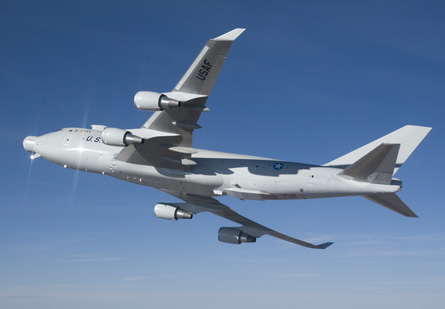Only months after rescuing the YAL-1 Airborne Laser from potentially fatal budget cuts, Boeing now wants the US Missile Defense Agency to speed up plans for acquiring a second aircraft.
The prime contractor for the YAL-1 - a 747-400F modified with a 102,000kg (225,000lb) chemical oxygen iodine laser (COIL) - fears that the MDA will follow up a planned shootdown test in August 2009 with a lengthy pause in development activity.
MDA officials have likened such a pause for ABL to the recent history of the Terminal High Altitude Area Defense programme, which was put on hiatus for several years after a series of shootdown tests in the late 1990s.
 |
|---|
© US Missile Defense Agency |
"We would hope that doesn't become a reality," says Mike Rinn, Boeing's newly appointed vice-president for ABL.
Instead, Boeing is lobbying to begin developing the second aircraft - dubbed Tail 2 - immediately after the long-awaited shootdown attempt scheduled in about 18 months.
The MDA has budgeted to pay Boeing $15.8 million in fiscal year 2009 to continue trade studies for Tail 2.
Boeing's 747-400 production line closes next year, so the company is evaluating alternative platforms. The 777F, 747-400BCF and even the Airbus A380F has been evaluated, but Boeing clearly favours shifting the ABL platform to the next-generation 747-8F (pictured below), says Rinn.
As the ABL system has increased in weight from 81,600kg to 102,000kg, the 747-8Fs's redesigned wing and General Electric GEnx-2B turbofan engines make it an ideal new platform for the ABL.
 |
|---|
© Boeing |
The ABL is a weapons system that uses six modules to create a 1MW-class beam strong enough to knock down a ballistic missile in boost phase at a range of 460km (250nm). The system also includes a beam control/fire control system capable of correcting for atmospheric distortion at those ranges.
The MDA's long-term vision for ABL is to deliver a fleet of seven aircraft to enter operational service late next decade, with this number needed to maintain a constant airborne patrol over a period of weeks.
Boeing's allies in the US Congress last year thwarted an attempt to cripple the programme by withdrawing most of the programme's FY2008 budget.
Meanwhile, Japanese industry may soon play a greater role in the programme. Boeing is formally evaluating Japan's industrial base to identify potential areas for collaboration, says Rinn, and that study should be complete in the third quarter.
Source: FlightGlobal.com



















